fMRI: Neurodevelopment & Clinical Applications
Oral
fMRI
Tuesday, 19 June 2018
| N03 |
16:15 - 18:15 |
Moderators: Moriah Thomason, Tomoki Arichi |
16:15
 |
0588.
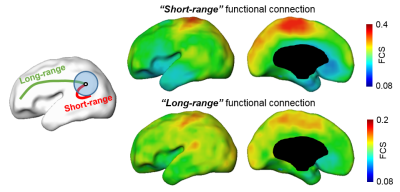 |
 Short-range functional connections at birth predict neurodevelopmental outcome at 2 years of age Short-range functional connections at birth predict neurodevelopmental outcome at 2 years of age
Minhui Ouyang, Qinmu Peng, Michelle Slinger, Hao Huang
Short-range functional connectivity (FC) is the major contributor to overall significant FC increases around birth. With critical role of short-range FC in neonate brain maturation, we hypothesized that short-range FC at birth predicts the neurodevelopmental outcome at 2 years of age. We measured short-range FC with neonatal resting-state fMRI and used support vector regression (SVR) to predict cognitive scores at 2 years of age. A highly predictive model was achieved with inhomogeneous feature contribution pattern across cortical areas. Significant correlation was found between short-range FC strength in widespread brain regions at birth and cognitive scores at 2 years of age.
|
16:27
|
0589.
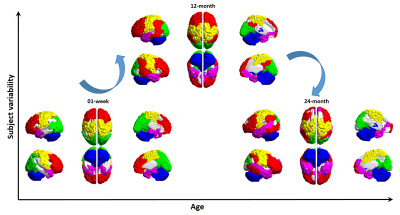 |
 “Multi-Layer Connectome” for Robust Multi-Subject Brain Network Analysis and its Application to Baby Connectome Development Study “Multi-Layer Connectome” for Robust Multi-Subject Brain Network Analysis and its Application to Baby Connectome Development Study
Han Zhang, Weili Lin, Dinggang Shen
We propose a multi-layer connectome analysis method that extends the existing majority of single-layer brain network studies. In this method, multiple subjects’ connectome constitutes a multi-layer hyper-network with hyper-edges across layers. Result from applying this method to delineating neonatal brain development indicates that our method can capture robust group-level modules while keeping meaningful individual variability. The “increasing functional segregation/integration” model is further refined by us with a “consistent large-scale functional segregation/integration” with “rewiring-induced module refinement”, as well as an invert-U-shaped subject variability in modular structure in the first two years of life.
|
16:39
|
0590.
 |
 Resting-state functional connectivity alterations in adolescents with fetal alcohol spectrum disorders Resting-state functional connectivity alterations in adolescents with fetal alcohol spectrum disorders
Jia Fan, Joseph Jacobson, Christopher Molteno, Sandra Jacobson, Ernesta Meintjes
In a study of children with fetal alcohol spectrum disorders (FASD) and community controls assessed at age 11 years, alcohol-exposed children showed localised dose-dependent reductions in resting state functional connectivity (FC) in 5 gray matter regions within 5 resting state networks. Here we present data from a follow-up study of these children at age 15 years to examine whether these FC deficits persist or resolve.
|
16:51
|
0591.
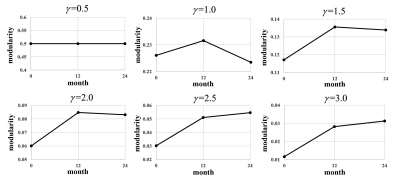 |
 Early Development of Modular Organization in Brain Functional Networks at Multiple Scales Early Development of Modular Organization in Brain Functional Networks at Multiple Scales
Xuyun Wen, Han Zhang, Jun Zhang, Gang Li, Weili Lin, Dinggang Shen
Increasing studies focus on delineating the development of brain networks of infants by detecting the corresponding modular organization. However, in these papers, the adopted module detection method, i.e., maximizing modularity, has a resolution limit, such that modular structures could only be investigated at a particular scale. To address this issue, by leveraging a novel multi-resolution modularity detection method, we explored the development of modular organization of human brain functional networks in the first 2 postnatal years at multiple scales. Our results showed that, different scales can uncover different developmental patterns of brain networks from different perspectives.
|
17:03
|
0592.
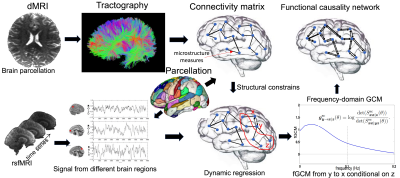 |
 Integrated structural and functional connectivity analysis to characterize abnormalities in ADHD Integrated structural and functional connectivity analysis to characterize abnormalities in ADHD
Lipeng Ning, Sarina Karmacharya, Hesham Hamoda, Gloria McAnulty, Deborah Waber, Yogesh Rathi
We introduce a novel approach for integrating novel diffusion MRI (dMRI) derived microstructural properties and resting state functional MRI (rsfMRI) derived functional measures to obtain a comprehensive understanding of brain abnormalities in neuropsychiatric disorders. We applied this methodology to study abnormalities in children with attention-deficit hyperactivity disorder (ADHD), providing a probabilistic view of the abnormal connections, thus accounting for the heterogeneity in the presentation of ADHD. We further show that the integrated analysis is significantly more sensitive than separate dMRI and rsfMRI analyses. Apart from known connections reported to be abnormal in the literature, we find several new abnormal connections in ADHD subjects with high probability.
|
17:15
|
0593.
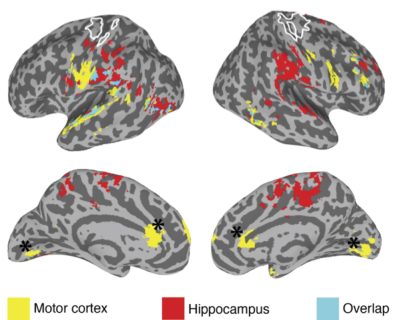 |
 Finding the baby in the bath water – evidence for task-specific changes in resting state functional connectivity evoked by training Finding the baby in the bath water – evidence for task-specific changes in resting state functional connectivity evoked by training
Cibu Thomas, Adam Steel, Aaron Trefler, Gang Chen, Chris Baker
Resting-state fMRI (rsFMRI) has been used for studying training-related changes in brain function during the offline period of skill learning. However, the lack of experimental control during “rest” makes it difficult to separate the impact of training from technical artifacts and experimental confounds like time-of-day (TOD) related changes in MRI signal. Here, by using multiple tasks (rest, visuo-spatial training, motor sequence training), we mapped out the spatial topography of changes in rsFC evoked by TOD and by training. Our findings suggest that task-specific changes in rsFC due to visuo-spatial and motor-sequence learning are dissociable from changes due to TOD.
|
17:27
|
0594.
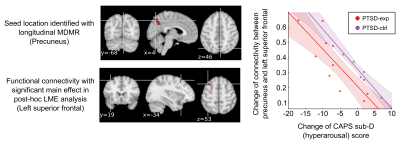 |
 A connectome-wide investigation of the longitudinal effect of real-time fMRI amygdala neurofeedback emotional training on resting-state connectivity in combat veterans with PTSD A connectome-wide investigation of the longitudinal effect of real-time fMRI amygdala neurofeedback emotional training on resting-state connectivity in combat veterans with PTSD
Masaya Misaki, Raquel Phillips, Vadim Zotev, Chung-Ki Wong, Brent Wurfel, Frank Krueger, Matthew Feldner, Jerzy Bodurka
We introduced a longitudinal Multivariate Distance Matrix Regression (LMDMR) analysis for a connectome-wide study of the longitudinal effect on resting-state fMRI functional connectivity (rsfMRI-fc) without a priori seed definition. We applied this analysis to investigate the effect of real-time fMRI amygdala neurofeedback training in combat veterans with PTSD. The analysis revealed a significant interaction between a decrease in hyperarousal symptom and an increase in rsfMRI-fc between the precuneus and the left superior frontal region. This result suggests that enhanced regulation of emotional memory retrieval helped reduce PTSD symptoms.
|
17:39
 |
0595.
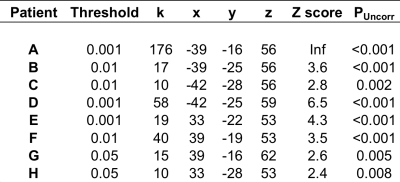 |
 Intra-operative acquisition of sensorimotor fMRI during glioma resection: evaluation of feasibility and clinical applicability. Intra-operative acquisition of sensorimotor fMRI during glioma resection: evaluation of feasibility and clinical applicability.
Adam Yamamoto, Joerg Magerkurth, Laura Mancini, Mark White, Samira Kazan, Anna Miserocchi, Andrew McEvoy, Ian Appleby, John Thornton, Cathy Price, Nikolaus Weiskopf, Tarek Yousry
Intra-operative fMRI has the potential to improve neurosurgical outcomes and we have previously shown that the task-related BOLD signal can be acquired under general anaesthesia. Our next goal was to acquire fMRI intra-operatively with the skull open.
In 12 patients, we performed 24 acquisitions of a passive sensorimotor paradigm during the resection of their brain tumour. The fMRI data were evaluated by neuroradiologists, assessing its applicability for the provision of a clinical report on the location of sensorimotor activation to the neurosurgeon. 17/24 acquisitions were scored as useful.
We conclude that intra-operative fMRI is feasible and produces clinically useful data.
|
17:51
|
0596.
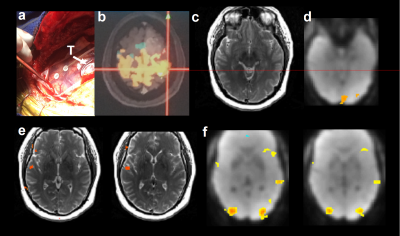 |
 Real-Time Resting-state fMRI for Presurgical Mapping in Patients with Brain Tumors Real-Time Resting-state fMRI for Presurgical Mapping in Patients with Brain Tumors
Kishore Vakamudi, Mohammad Chohan, Howard Yonas, Mona Chaney, Stefan Posse
We investigated the feasibility of presurgical mapping in patients with brain tumors using real-time rsfMRI analysis methodology in combination with high-speed multi-band EPI. The objective was to map sensorimotor and language resting state networks in the vicinity of brain tumors and to monitor data quality online. We validated this approach in comparison with tfMRI and intra-operative electrocorticography (ECog). The data in patients show a high degree of consistency between resting state connectivity, task-based activation and ECS localization of motor cortex and Broca’s area. Localization of Wernicke’s area was more variable, both in rsfMRI and tfMRI.
|
18:03
|
0597.
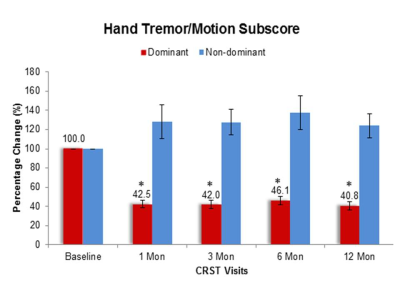 |
 Association between Tremor Severity Improvement and Functional Connectivity Changes after Magnetic Resonance Guided Focused Ultrasonic Thalamotomy Treatment in Essential Tremor Patients Association between Tremor Severity Improvement and Functional Connectivity Changes after Magnetic Resonance Guided Focused Ultrasonic Thalamotomy Treatment in Essential Tremor Patients
Li Jiang, Jiachen Zhuo, Dheeraj Gandhi, Charlene Aldrich, Howard Eisenberg, Paul Fishman, Elias Melhem, Rao Gullapalli
Essential tremor (ET) is the most common movement disorder and often characterized by a slowly progressive involuntary posture and/or kinetic tremor, usually affecting both upper extremities. Ablation of the ventral intermediate nucleus (VIM) of the thalamus with MRgFUS is an effective and FDA-approved treatment for medication refractory ET patients. However, very little is known regarding brain functional changes before and after the treatment and even less about its association with the tremor severity changes after treatment. This study aimed at investigating the longitudinal tremor improvement and its association with the changes of Functional connectivity of left VIM at 1-year post-treatment.
|
|












